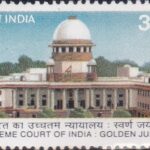
Supreme Court of India 2024
A commemorative postage stamp on 75 years of the Supreme Court of India :

 Issued by India
Issued by India
Issued on Aug 31, 2024
Issued for : Department of Posts is proud to issue a Commemorative Postage Stamp on the Supreme Court of India and its contribution in the Indian judicial system, shaping the legal landscape of the nation while upholding the rule of law and the rights of its citizens.
Credits :
Stamp/FDC/Brochure/Cancellation Cachet : Ms. Nenu Gupta
Type : Stamp, Mint Condition
Colour : Multi Colour
Denomination : 1000 Paise
Miniature Sheets Printed : 211000
Printing Process : Wet Offset
Printer : Security Printing Press, Hyderabad
About :
- By the start of the 18th century, judicial administration in the three presidency towns was poised for significant transformation, including the establishment of a formal court hierarchy and the setting up of the Supreme Court of Judicature in 1823. Subsequently, the Indian High Courts Act of 1861 led to the creation of three High Courts in Calcutta, Bombay, and Madras in 1862. Each court has made its mark on the legal history of India, producing prominent lawyers and judges and establishing precedents foundational to the common law system in the country.
- During the first session of the Indian Round Table Conference in London in November 1930, a pivotal announcement was made by representatives of the Indian States. They declared their readiness to federate with British India, provided the proposed federation remained free from British control. Lord Chancellor Lord Sankey emphasized that a Federal Court was essential in a federal system of government.
- The second session of the conference saw the federal structure committee submits its Third Report, which included provisions for establishing a Federal Court. The Government of India Act of 1935 consequently set up a Federal Court with original and appellate jurisdiction, extending its authority over disputes involving the Provinces and the Provincial High Courts, aimed at reducing Indian appeals to the Privy Council by shifting them to an indigenous appellate court.
- The Constituent Assembly of India was formed in 1946 by the British Cabinet Mission Plan, outlining the assembly’s functions and structure. Following India’s independence on 15 August 1947, the Abolition of Privy Council Jurisdiction Bill was introduced in 1949. During discussions, Shri Alladi Krishnaswami Ayyar expressed hope that both the Federal Court and the Supreme Court would develop jurisprudence that reflected the ethos of the Indian people.
- The Supreme Court of India was established on 28 January 1950, two days after India became a Sovereign Democratic Republic. The inaugural ceremony took place in the Chamber of Princes in the Parliament building, the Federal Court’s home from 1937 to 1950. The Court later moved to its present building in 1958, which is designed to symbolize the scales of justice. The Central Wing represents the Centre Beam of the Scales, with two new wings added in 1979. There are now 19 courtrooms across these wings.
- Initially, the Constitution of 1950 envisaged a Supreme Court with a Chief Justice and 7 puisne Judges, with the provision for Parliament to increase this number. Over the years, as case backlogs accumulated, the number of Judges has been increased periodically, with the current strength at 34. Judges now typically sit in smaller Benches, except in matters of constitutional importance where larger Benches are convened.
- The Supreme Court of India includes the Chief Justice and up to 33 other Judges, appointed by the President. Judges retire at the age of 65. To be appointed, a candidate must be a citizen of India with at least five years as a High Court Judge or ten years as a High Court Advocate, or be recognized as a distinguished jurist by the President. The independence of the Judges is protected by the Constitution, which stipulates that a Supreme Court Judge can only be removed by a presidential order following a parliamentary majority.
- The Supreme Court has original, appellate, and advisory jurisdiction. Its exclusive original jurisdiction covers disputes involving the Government of India and the States, or among States themselves, especially if these disputes involve legal rights. The Supreme Court also has extensive appellate jurisdiction over civil and criminal cases from High Courts and can grant special leave to appeal under Article 136. Its advisory jurisdiction allows it to consider matters referred by the President under Article 143.
- Public Interest Litigation (PIL) is a unique aspect of the Supreme Court, allowing any individual or group to bring matters of public interest directly to the court. The concept has led to many landmark cases. Additionally, provisions for legal aid are available for those unable to afford legal representation, ensuring access to justice.
- The Supreme Court has original, appellate, and advisory jurisdiction. Its exclusive original jurisdiction extends to any dispute between the Government of India and one or more States or between the Government of India and any State or States on one side and one or more States on the other or between two or more States, if and insofar as the dispute involves any question (whether of law or fact) on which the existence or extent of a legal right depends. In addition, Article 32 of the Constitution gives extensive original jurisdiction to the Supreme Court in regard to enforcement of Fundamental Rights.
- Text : Based on information received from Supreme Court of India.
Subscribe
Login
0 Comments
Oldest







